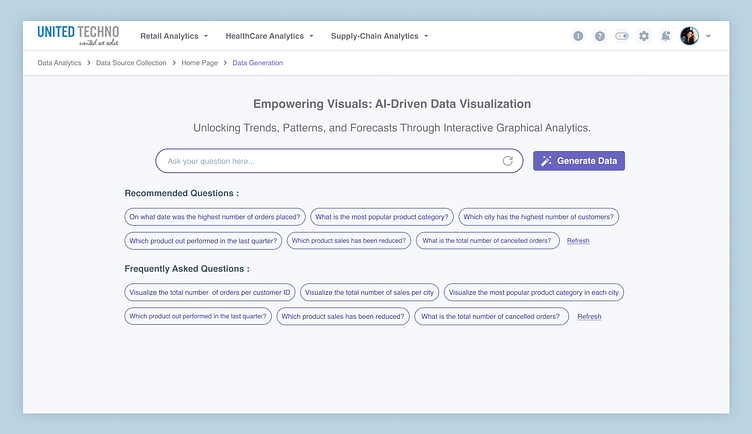AI - Driven Data Visualization Dashboard
AI-Driven Data Visualization: Visual GPT
Visual GPT is a cutting-edge platform that leverages artificial intelligence to transform raw data into insightful visualizations. Designed to empower analysts, business users, and decision-makers, Visual GPT simplifies data analysis, making it easy to interpret complex data and drive informed decisions.
UI/UX Design Journey: Visual GPT
In designing the user interface (UI) and user experience (UX) of Visual GPT, our mission was to seamlessly integrate advanced AI capabilities with an intuitive and visually engaging platform. Here’s a detailed look at our design journey:
1.User-Centric Research:
We began by deeply understanding the needs and challenges faced by data analysts and business users. Through extensive user research, we identified key features and prioritized user requirements to ensure a valuable and relevant platform.
2.Intuitive Information Architecture:
Creating a clear and logical structure was essential. We organized the platform’s features cohesively, ensuring users could easily navigate between different data analysis tools. Intuitive menus and categorizations simplified the process of transforming data into visual insights.
3.Clean and Engaging Visual Design:
Our design team focused on a clean and visually appealing interface. We employed a modern and harmonious color palette, enhancing readability and the overall user experience. Strategic placement of engaging visuals guided users’ attention to essential data points and insights.
4.Streamlined User Flows:
Every interaction within Visual GPT was meticulously crafted. From uploading data files to generating visualizations and analyzing insights, we streamlined user flows to minimize clicks and maximize efficiency. Clear calls-to-action guided users seamlessly through their tasks.
5.Interactive Prototyping:
To validate our design concepts, we created interactive prototypes. These clickable models allowed us to simulate user interactions, ensuring the platform felt responsive and intuitive. User feedback from these prototypes was invaluable in refining our designs.
6.Responsive Design for Multi-Platform Access:
Recognizing the diverse devices users would employ, we implemented a responsive design approach. Visual GPT adapts seamlessly to various screen sizes, guaranteeing a consistent and enjoyable experience on desktops, tablets, and smartphones.
What was done
Research
UX/UI Design
Prototype
Interaction
What tools did we use?
Figma
Adobe AfterEffects
